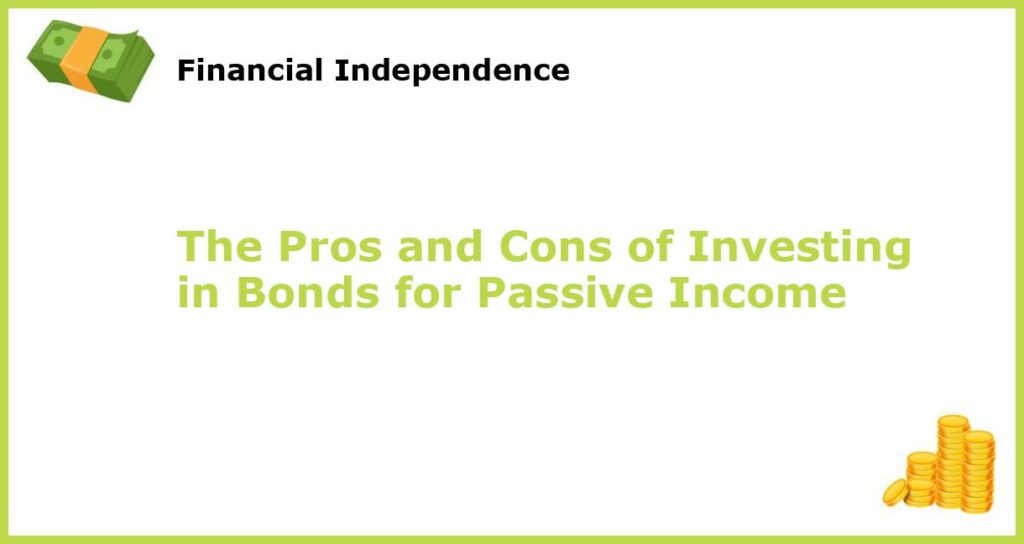Bonds have become an attractive option for investors who are looking for passive income sources. These are fixed income securities that pay interest to the investor on a regular basis. Bonds come in different types and have varying degrees of risk, and returns. However, before jumping into investing in bonds, there are pros and cons to consider.
The Advantages of Investing in Bonds

Bonds are a low-risk investment option. This is one of the primary benefits of investing in bonds. Compared to stocks, bonds are seen as a safer investment because they offer a guaranteed return. Additionally, bonds have a more stable market value compared to some stocks that experience significant price fluctuations.
Bonds are a good option for those who prefer regular income payments. Bonds pay interest to the investor on a regular basis, either monthly, quarterly, or annually. This makes bonds a predictable source of passive income that can supplement one’s overall investment returns.
Another advantage of investing in bonds is their wide availability. Governments, corporations, and municipalities all issue bonds, which provides investors with a greater diversity of options to select from based on their needs and financial goals.
The Drawbacks of Investing in Bonds

Despite the numerous benefits of investing in bonds, there are drawbacks to consider. One downside to bonds is their lower potential for returns compared to other investment options such as stocks or mutual funds. Bond interest rates are fixed, meaning their returns may be impacted negatively by inflation.
Bond prices can fluctuate with interest rates. Interest rates often have an inverse relationship with bond prices; when interest rates rise, bond prices decrease, causing the value of the bond to drop. However, there is a silver lining to this phenomenon. If interest rates drop, bond prices will increase, raising the bond’s value.
Additionally, bonds have more rigid returns compared to the stock market’s volatility, which can lead to less opportunity for capital appreciation. This can affect long-term investment goals.
Types of Bonds Available for Investors

There are different types of bonds to select from for investment purposes. One is government bonds which are issued by the government to fund budget deficits or finance specific initiatives such as infrastructure projects. These are considered safe to invest in, but with lower returns.
Creditworthy companies issue corporate bonds to finance their operations or expansions. These carry a higher risk compared to government bonds but offer better rates of return.
Municipal bonds are issued by state and local governments to raise funds for projects. These are tax-free for most investors, and are considered as an option for investors in a higher tax bracket.
The Risks Associated with Bond Investing

While bonds are less risky than stocks generally, there are still risks associated with bond investing. One risk, in particular, is the potential for default. If the bond issuer is unable to make its payment, an investor may lose their invested money. Corporate and municipal bond investors, in particular, should thoroughly research the bond issuer before investing in them.
Investors may experience inflation risk or interest rate risk associated with bond investing. Inflation risk occurs when interest rates rise above the inflation rate, reducing the actual earning power of cash generated by bond interest. Interest rate risk occurs when interest rates rise causing bond prices to fall.
How to Invest in Bonds

Individuals may purchase bonds directly when the bond is issued, but most people invest in bonds through funds. Funds offer diversification and access points to bond markets, but with a lower risk.
One way to invest in bonds is through mutual funds. Bond mutual funds are professionally managed and can offer diversification by investing in many different types of bonds. This allows investors to experience fewer risks associated with individual bond investing.
Exchange-traded funds (ETFs) can also provide investors with exposure to bond markets. Like mutual funds, ETFs invest in many different types of bonds, providing a level of diversification and minimizing risk.
Factors to Consider When Investing in Bonds

Before investing in bonds, investors must research creditworthiness, maturity dates, yield, and coupon rates. These factors help to identify the bond type and issuer that is suitable for investment objectives, risk tolerance, and investment strategy.
Investors should also identify the bond’s duration, which is the time required for any investor to receive their investment back. Short-term bonds may have lower interests but lower risks too, while long-term bonds may have higher rates but have more significant risks associated with potential interest rate fluctuations.
Tax Implications of Bond Investing

Tax implications should be considered by investors in higher tax brackets. Interest earned from certain types of bonds is subject to federal and state income taxes, so it’s essential to understand how taxes affect returns. Municipals bonds, however, may offer tax-free returns under certain circumstances.
Other Options for Passive Income

While bonds offer a reliable and predictable source of passive income, other options are available. Peer-to-peer lending offers high-interest returns but with a higher risk involved as borrowers may default on their loans. Dividend investing in the stock market provides a higher rate of return, but with much more associated risks. Rental property ownership provides monthly cash flow, but carries a higher level of effort and management responsibility.
Maintaining a Balanced Investment Portfolio
A balanced investment portfolio helps to minimize risks and maximize returns. Diversification of investments across various asset classes and selecting investments with varying degrees of risk and returns can reduce the chances of losing all of one’s investment. By doing so, a more stable and profitable investment portfolio is built.
Final Thoughts on Investing in Bonds for Passive Income
Bonds offer many benefits, including regular income payments and lower risk levels, which are appealing factors for those seeking a passive income. With careful research and planning, investors can minimize their risks and achieve steady returns from bond investing. However, it is essential to consider the drawbacks such as lower potential returns and the impacts of inflation and interest rates on bond investments. Investors should weigh the pros and cons of different income options available before settling on one that suits their needs and goals.







